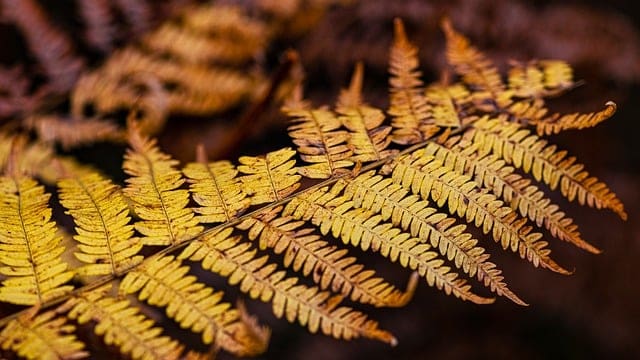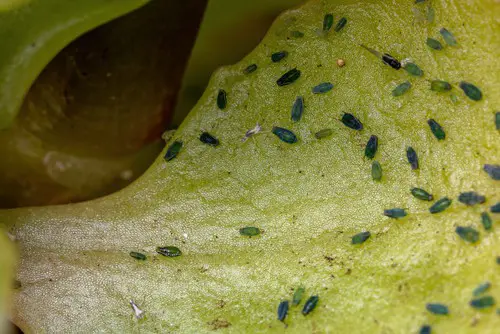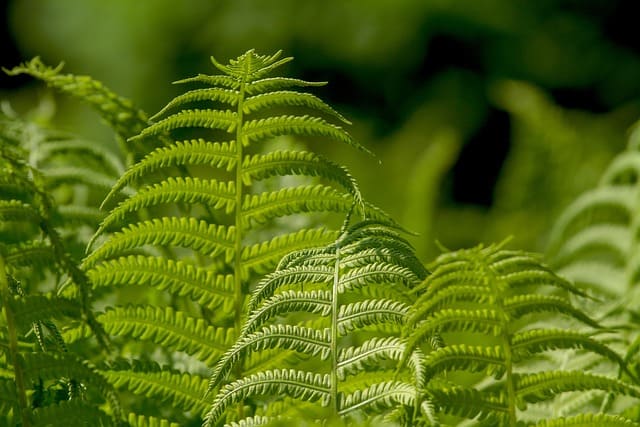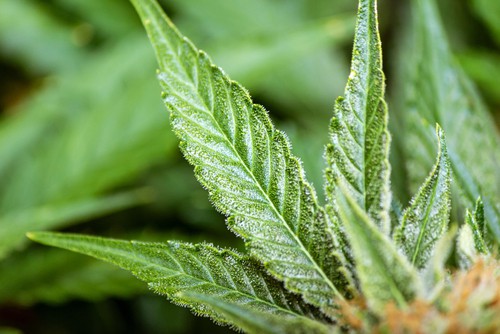Ferns are a popular houseplant due to their lush green foliage and low-maintenance requirements. However, black spots on fern leaves can be a common problem for plant owners. These unsightly spots not only detract from the plant’s appearance but can also indicate underlying issues that need to be addressed.
Understanding the causes of black spots on fern leaves is crucial to effectively treating and preventing them. Overwatering is a common culprit, as it can encourage the growth of fungal diseases that cause black spots.
Other factors, such as pests, diseases, and environmental conditions, can also play a role. By identifying the cause of the problem, plant owners can take steps to address it and keep their ferns healthy and vibrant.
Key Takeaways
- Black spots on fern leaves can indicate underlying issues that need to be addressed.
- Overwatering is a common cause of black spots on fern leaves.
- Identifying the cause of the problem is crucial to effectively treating and preventing black spots on fern leaves.
See these other top posts in this category:
Understanding Black Spots on Fern Leaves

Black spots on fern leaves can be a sign of several problems, including fungal diseases, insect infestations, and environmental stress. One of the most common fungal diseases that causes black spots on fern leaves is called black spot or leaf spot. This disease is caused by the fungus Cercospora and can affect many types of ferns.
Overwatering is another common cause of black spots on fern leaves. While ferns need consistent moisture to thrive, too much water can cause the leaves to turn black and drop off. Overwatering encourages the growth of fungal diseases, which can quickly overwhelm the plant.
In addition to overwatering, underwatering can also cause black spots on fern leaves. When a fern doesn’t receive enough water, its leaves can turn black and dry out. It’s important to maintain even soil moisture at all times to prevent this from happening.
Environmental stress can also cause black spots on fern leaves. For example, if a fern is exposed to too much direct sunlight, its leaves can turn black and die. Similarly, if a fern is exposed to cold temperatures or drafts, its leaves can also turn black.
To prevent black spots on fern leaves, it’s important to provide the right growing conditions. This includes ensuring that the fern has enough water, but not too much, and is not exposed to direct sunlight or cold temperatures. Additionally, it’s important to keep the fern’s soil healthy and free of pests and diseases.
If black spots do appear on fern leaves, it’s important to take action quickly to prevent the problem from getting worse. This may involve removing infected leaves, treating the fern with a fungicide, or adjusting its growing conditions. With the right care, most ferns can recover from black spot and other problems that cause black spots on their leaves.
Common Causes of Black Spots
Black spots on fern leaves can be caused by a variety of factors, including overwatering, direct sunlight, sunburn, disease, pest infestation, and fungal diseases.
Overwatering is one of the most common causes of black spots on fern leaves. When the soil is too wet, the roots will rot and the leaves will turn black. On the other hand, if the soil is too dry, the leaves will wilt and turn brown or black. It is essential to maintain the right balance of moisture in the soil to prevent black spots from forming on fern leaves.
Direct sunlight can also cause black spots on fern leaves. Ferns are shade-loving plants, and too much sun exposure can cause the leaves to burn and turn black. It is best to keep ferns in a shaded area or indirect sunlight to prevent sunburn.
Pest infestation can also cause black spots on fern leaves. Aphids, mealybugs, and spider mites are common pests that can attack ferns. Aphids and mealybugs will suck the sap from the leaves, causing them to turn black. Spider mites can also cause black spots on the leaves as they feed.
Fungal diseases such as rhizoctonia blight, bacterial leaf spot, and bacteria blight can cause black spots on fern leaves. These diseases are caused by fungi and bacteria that thrive in moist conditions. To prevent fungal diseases, it is essential to maintain proper air circulation and avoid overwatering.
Leaf tip burn is another common cause of black spots on fern leaves. This occurs when the tips of the leaves dry out and turn black. Leaf tip burn can be caused by a lack of humidity or exposure to dry air. It is essential to maintain proper humidity levels to prevent leaf tip burn.
Pests and Diseases

Ferns are susceptible to a variety of pests and diseases that can cause black spots on their leaves. In this section, we will discuss how to recognize pest infestations and identify fungal and bacterial diseases that can affect ferns.
Recognizing Pest Infestation
Pests such as scale insects, spider mites, mealybugs, and aphids can infest ferns and cause black spots on their leaves. These pests feed on the sap of the ferns, causing the leaves to turn black. To identify pest infestations, look for small insects or webs on the leaves. You may also notice that the leaves are turning black and falling off the plant.
To control pest infestations, you can use horticultural oils such as neem oil or insecticidal soap. These products can be sprayed on the leaves of the ferns to kill the pests. It is also important to keep the ferns well-watered and fertilized to help them resist pest infestations.
Identifying Fungal and Bacterial Diseases
Fungal and bacterial diseases can also cause black spots on fern leaves. These diseases are caused by spores that can be spread by water, insects, or other means. Common fungal pathogens that can affect ferns include Rhizoctonia, Pythium, and Phytophthora. Bacterial blight is another disease that can cause black spots on fern leaves.
To identify fungal and bacterial diseases, look for black spots on the leaves that are surrounded by yellow or brown halos. The spots may also be accompanied by wilting or yellowing of the leaves.
To control these diseases, it is important to keep the ferns well-ventilated and free from excess moisture. Avoid overhead watering and remove any infected leaves or plants to prevent the spread of the disease.
Impact of Environmental Conditions
Ferns are delicate plants that require specific environmental conditions to thrive. The presence of black spots on fern leaves can be an indication of environmental stress. In this section, we will explore the impact of environmental conditions on fern leaves and how they relate to the formation of black spots.
Role of Light and Sunlight
Light plays a crucial role in the growth and development of ferns. While ferns require light to grow, too much direct sunlight can be detrimental to their growth. Direct sunlight can cause black spots to form on fern leaves as a result of sunburn. In contrast, indirect sunlight is beneficial to ferns, as it provides the necessary light without causing damage to the leaves.
Importance of Moisture and Watering

Moisture is another critical factor in the growth and development of ferns. Ferns require consistent moisture to thrive, but overwatering can lead to root rot and the formation of black spots on the leaves.
It is essential to water ferns correctly to avoid waterlogging the soil. Additionally, high humidity levels can also lead to fungal diseases that cause black spots to form on fern leaves.
Effect of Wind and Air Circulation
Ferns require adequate air circulation to thrive. Poor air circulation can lead to the formation of black spots on fern leaves. Stagnant air can lead to the growth of fungi and bacteria, which can cause black spots to form on the leaves. It is essential to ensure that ferns are planted in areas with good air circulation to avoid this problem.
Prevention and Treatment
1. Using Fungicides and Insecticides
If black spots are caused by fungal or insect infestations, using fungicides and insecticides can help treat the problem. However, it is important to choose the right product for the specific type of fungus or insect that is affecting the fern. Neem oil is a natural and effective option for controlling both fungal and insect issues.
2. Proper Watering Techniques
Overwatering is a common cause of black spots on fern leaves. To prevent this issue, it is important to ensure that the soil is well-draining and to water the fern only when the top inch of soil is dry. It is also important to avoid getting water on the leaves, as this can encourage fungal growth.
3. Appropriate Sunlight Exposure
Ferns prefer indirect or filtered sunlight. Direct sunlight can cause the leaves to turn black and dry out. To prevent this issue, it is important to place the fern in a location where it will receive the appropriate amount of sunlight.
4. Effective Use of Compost and Soil

Using high-quality compost and soil can help prevent black spots on fern leaves. Compost can improve soil drainage and provide essential nutrients for the fern, while good quality soil can help prevent fungal growth.
Caring for New Growth
When caring for ferns, it is important to keep an eye on new growth. New growth is a sign that the plant is healthy and thriving. However, it is also important to ensure that the new growth is not being affected by any issues that may cause the leaves to turn black or yellow.
One of the most common issues that affect new growth is overwatering. Overwatering can cause the roots to rot, which can lead to the leaves turning black or yellow. To avoid this issue, it is important to ensure that the soil is well-draining and that the fern is not sitting in water.
Another issue that can affect new growth is a lack of nutrients. Ferns require a balanced fertilizer to ensure that they have enough nutrients to thrive. It is important to follow the instructions on the fertilizer packaging to avoid over-fertilizing, which can also cause the leaves to turn black or yellow.
In addition to watering and fertilizing, it is important to ensure that the fern is getting enough light. Too much or too little light can cause the leaves to turn black or yellow. Most ferns prefer indirect, filtered light, so it may be necessary to move the plant to a different location to ensure that it is getting the right amount of light.
Finally, it is important to keep an eye out for any signs of pests or disease. Pests and disease can quickly spread and cause the leaves to turn black or yellow. If any issues are detected, it is important to take action immediately to prevent further damage.
By following these tips, it is possible to ensure that new growth on ferns remains healthy and vibrant, and that the leaves do not turn black or yellow.
Role of Houseplants in Human Life

Houseplants play an important role in human life. They are not only aesthetically pleasing but also provide numerous benefits to humans. Houseplants are known to purify the air by removing harmful toxins and pollutants. They also help to reduce stress and anxiety, improve mood, and increase productivity.
Houseplants have been used for centuries in agriculture and gardening. They are grown for their beauty, medicinal properties, and nutritional value. Houseplants are also used to improve the quality of the soil and prevent soil erosion. They are an important part of the ecosystem and help to maintain the balance of nature.
Houseplants are popular among gardening experts as they are easy to grow and maintain. They require minimal care and can be grown in small spaces. Houseplants are also a great way to introduce children to the world of gardening and teach them about the importance of plants in our lives.
In addition to their aesthetic and environmental benefits, houseplants have also been found to have numerous health benefits. They are known to improve air quality, reduce stress and anxiety, and improve mood. They have also been found to help reduce the symptoms of certain illnesses and improve overall health.
Conclusion
Black spots on fern leaves can be caused by a variety of factors, including fungal diseases, insect infestations, and environmental stress. It is important to identify the cause of the black spots to effectively treat the issue and prevent further damage to the fern.
One of the most common fungal diseases that causes black spots on fern leaves is called black spot or leaf spot. This disease is caused by several species of fungi, including Cercospora, Phyllosticta, and Colletotrichum.
To prevent the spread of the disease, it is recommended to remove any infected leaves and avoid overhead watering, which can spread the spores of the fungus.
Insect infestations, such as scale insects and mealybugs, can also cause black spots on fern leaves. These insects feed on the sap of the plant, which can lead to leaf discoloration and damage. To prevent insect infestations, it is important to regularly inspect the fern for signs of pests and to keep the plant healthy with proper watering and fertilization.
Environmental stress, such as inadequate exposure to light or dehydration, can also cause black spots on fern leaves. It is important to provide the fern with the proper growing conditions, including adequate light and consistent moisture, to prevent stress and promote healthy growth.
Frequently Asked Questions
What causes dark spots to appear on fern leaves?
Dark spots on fern leaves can be caused by a variety of factors, including fungal diseases, bacterial infections, insect infestations, or environmental stressors. Overwatering or underwatering your fern can also cause dark spots to appear on the leaves.
How do I treat black spots on my fern leaves?
The treatment for black spots on fern leaves depends on the underlying cause. If the spots are caused by a fungal disease, you can try using a fungicide to treat the plant.
If the spots are caused by bacterial infections, you may need to remove the affected leaves and adjust the plant’s watering schedule. Insect infestations can be treated with insecticides, while environmental stressors can be addressed by adjusting the plant’s growing conditions.
Are black spots on fern leaves harmful to the plant?
In most cases, black spots on fern leaves are not harmful to the plant’s overall health. However, if the underlying cause is not addressed, the spots can spread and cause the leaves to yellow and die.
What are some natural remedies for black spots on fern leaves?
Natural remedies for black spots on fern leaves include using neem oil, chamomile tea, or a mixture of baking soda and water to treat the plant. These remedies can help to control fungal diseases and bacterial infections.
Can black spots on fern leaves be prevented?
Black spots on fern leaves can be prevented by providing the plant with proper growing conditions, including adequate light, water, and humidity. Avoid overwatering or underwatering the plant, and make sure to remove any dead or diseased leaves promptly to prevent the spread of infection.
How do I identify the type of fungus causing black spots on my fern leaves?
To identify the type of fungus causing black spots on your fern leaves, you may need to take a sample of the affected plant tissue to a plant diagnostic laboratory. The laboratory can perform tests to identify the specific type of fungus and recommend an appropriate treatment.

Hey, I’m Lisa and I’ve been an avid gardener for over 30 years. I love writing, talking and living in the garden! Feel free to connect with me on my socials below


